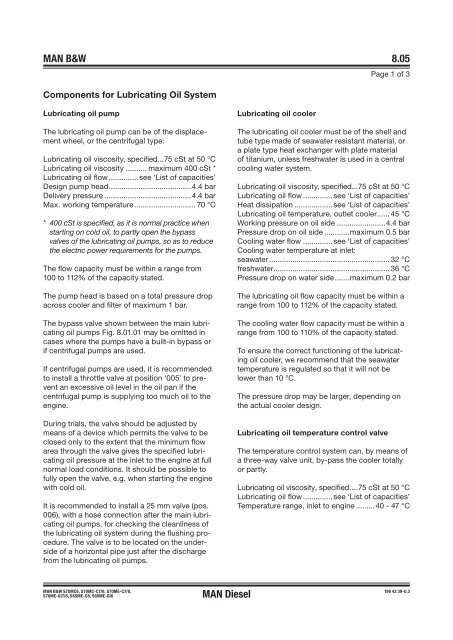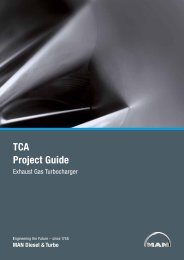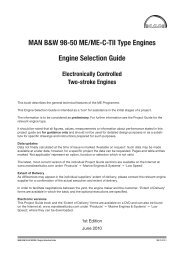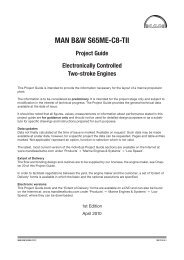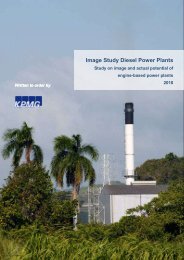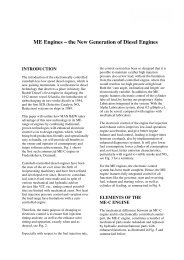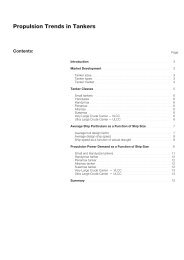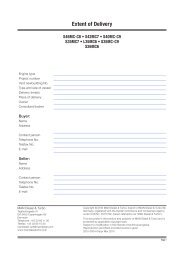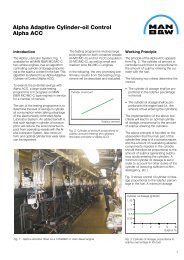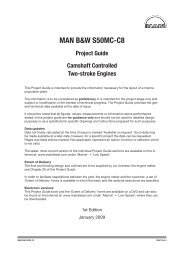This section is available on request - MAN Diesel & Turbo
This section is available on request - MAN Diesel & Turbo
This section is available on request - MAN Diesel & Turbo
You also want an ePaper? Increase the reach of your titles
YUMPU automatically turns print PDFs into web optimized ePapers that Google loves.
<strong>MAN</strong> B&W 8.05<br />
Comp<strong>on</strong>ents for Lubricating Oil System<br />
Lubricating oil pump<br />
The lubricating oil pump can be of the d<str<strong>on</strong>g>is</str<strong>on</strong>g>placement<br />
wheel, or the centrifugal type:<br />
Lubricating oil v<str<strong>on</strong>g>is</str<strong>on</strong>g>cosity, specified...75 cSt at 50 °C<br />
Lubricating oil v<str<strong>on</strong>g>is</str<strong>on</strong>g>cosity .......... maximum 400 cSt *<br />
Lubricating oil flow ..............see ‘L<str<strong>on</strong>g>is</str<strong>on</strong>g>t of capacities’<br />
Design pump head .......................................4.4 bar<br />
Delivery pressure .........................................4.4 bar<br />
Max. working temperature ............................. 70 °C<br />
* 400 cSt <str<strong>on</strong>g>is</str<strong>on</strong>g> specified, as it <str<strong>on</strong>g>is</str<strong>on</strong>g> normal practice when<br />
starting <strong>on</strong> cold oil, to partly open the bypass<br />
valves of the lubricating oil pumps, so as to reduce<br />
the electric power requirements for the pumps.<br />
The flow capacity must be within a range from<br />
00 to 2% of the capacity stated.<br />
The pump head <str<strong>on</strong>g>is</str<strong>on</strong>g> based <strong>on</strong> a total pressure drop<br />
across cooler and filter of maximum bar.<br />
The bypass valve shown between the main lubricating<br />
oil pumps Fig. 8.0 .0 may be omitted in<br />
cases where the pumps have a built�in bypass or<br />
if centrifugal pumps are used.<br />
If centrifugal pumps are used, it <str<strong>on</strong>g>is</str<strong>on</strong>g> recommended<br />
to install a throttle valve at positi<strong>on</strong> ‘005’ to prevent<br />
an excessive oil level in the oil pan if the<br />
centrifugal pump <str<strong>on</strong>g>is</str<strong>on</strong>g> supplying too much oil to the<br />
engine.<br />
During trials, the valve should be adjusted by<br />
means of a device which permits the valve to be<br />
closed <strong>on</strong>ly to the extent that the minimum flow<br />
area through the valve gives the specified lubricating<br />
oil pressure at the inlet to the engine at full<br />
normal load c<strong>on</strong>diti<strong>on</strong>s. It should be possible to<br />
fully open the valve, e.g. when starting the engine<br />
with cold oil.<br />
It <str<strong>on</strong>g>is</str<strong>on</strong>g> recommended to install a 25 mm valve (pos.<br />
006), with a hose c<strong>on</strong>necti<strong>on</strong> after the main lubricating<br />
oil pumps, for checking the cleanliness of<br />
the lubricating oil system during the flushing procedure.<br />
The valve <str<strong>on</strong>g>is</str<strong>on</strong>g> to be located <strong>on</strong> the underside<br />
of a horiz<strong>on</strong>tal pipe just after the d<str<strong>on</strong>g>is</str<strong>on</strong>g>charge<br />
from the lubricating oil pumps.<br />
<strong>MAN</strong> B&W S70MC6, S70MC-C7/8, S70ME-C7/8,<br />
S70ME-GI7/8, S65ME-C8, S65ME-GI8<br />
<strong>MAN</strong> <strong>Diesel</strong><br />
Lubricating oil cooler<br />
Page of 3<br />
The lubricating oil cooler must be of the shell and<br />
tube type made of seawater res<str<strong>on</strong>g>is</str<strong>on</strong>g>tant material, or<br />
a plate type heat exchanger with plate material<br />
of titanium, unless freshwater <str<strong>on</strong>g>is</str<strong>on</strong>g> used in a central<br />
cooling water system.<br />
Lubricating oil v<str<strong>on</strong>g>is</str<strong>on</strong>g>cosity, specified...75 cSt at 50 °C<br />
Lubricating oil flow ..............see ‘L<str<strong>on</strong>g>is</str<strong>on</strong>g>t of capacities’<br />
Heat d<str<strong>on</strong>g>is</str<strong>on</strong>g>sipati<strong>on</strong> ..................see ‘L<str<strong>on</strong>g>is</str<strong>on</strong>g>t of capacities’<br />
Lubricating oil temperature, outlet cooler ...... 45 °C<br />
Working pressure <strong>on</strong> oil side .......................4.4 bar<br />
Pressure drop <strong>on</strong> oil side ............maximum 0.5 bar<br />
Cooling water flow ..............see ‘L<str<strong>on</strong>g>is</str<strong>on</strong>g>t of capacities’<br />
Cooling water temperature at inlet:<br />
seawater ......................................................... 32 °C<br />
freshwater ....................................................... 36 °C<br />
Pressure drop <strong>on</strong> water side .......maximum 0.2 bar<br />
The lubricating oil flow capacity must be within a<br />
range from 00 to 2% of the capacity stated.<br />
The cooling water flow capacity must be within a<br />
range from 00 to 0% of the capacity stated.<br />
To ensure the correct functi<strong>on</strong>ing of the lubricating<br />
oil cooler, we recommend that the seawater<br />
temperature <str<strong>on</strong>g>is</str<strong>on</strong>g> regulated so that it will not be<br />
lower than 0 °C.<br />
The pressure drop may be larger, depending <strong>on</strong><br />
the actual cooler design.<br />
Lubricating oil temperature c<strong>on</strong>trol valve<br />
The temperature c<strong>on</strong>trol system can, by means of<br />
a three�way valve unit, by�pass the cooler totally<br />
or partly.<br />
Lubricating oil v<str<strong>on</strong>g>is</str<strong>on</strong>g>cosity, specified ....75 cSt at 50 °C<br />
Lubricating oil flow ..............see ‘L<str<strong>on</strong>g>is</str<strong>on</strong>g>t of capacities’<br />
Temperature range, inlet to engine .........40 � 47 °C<br />
198 42 39�0.3


